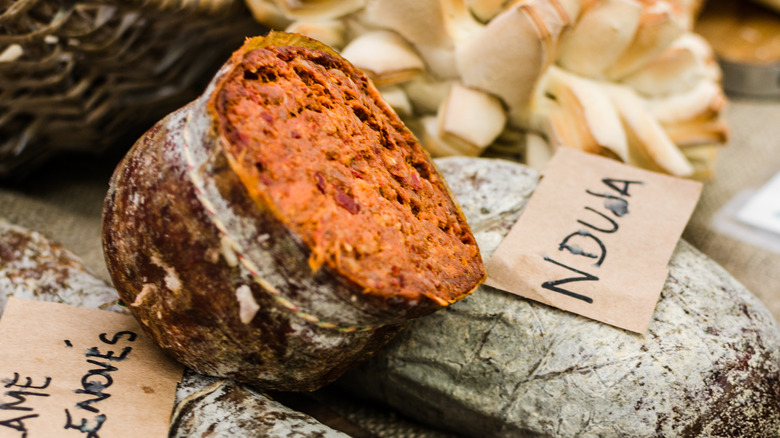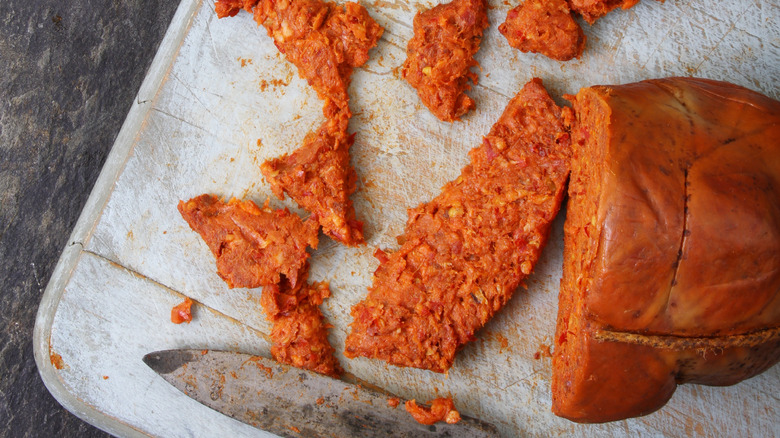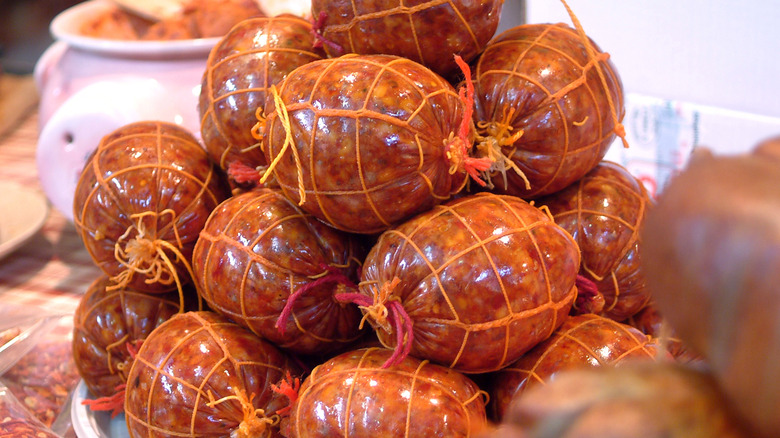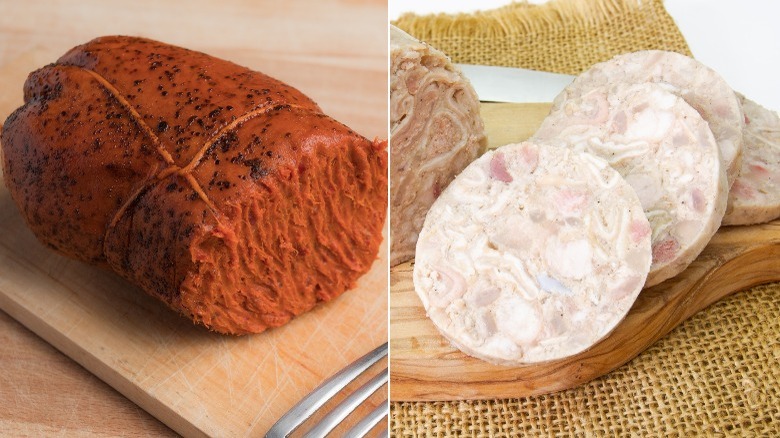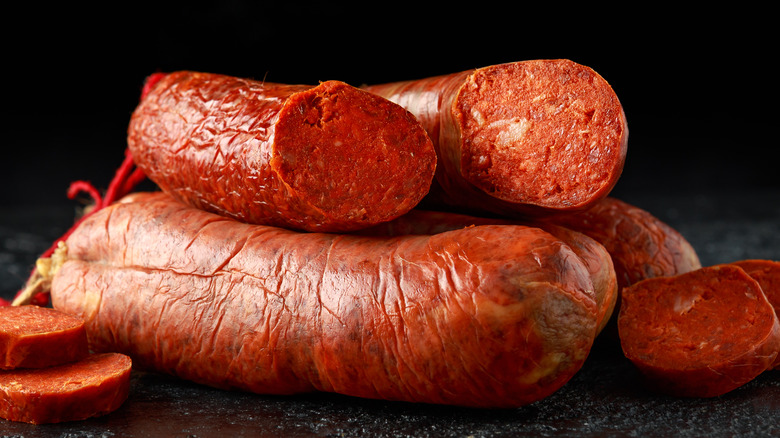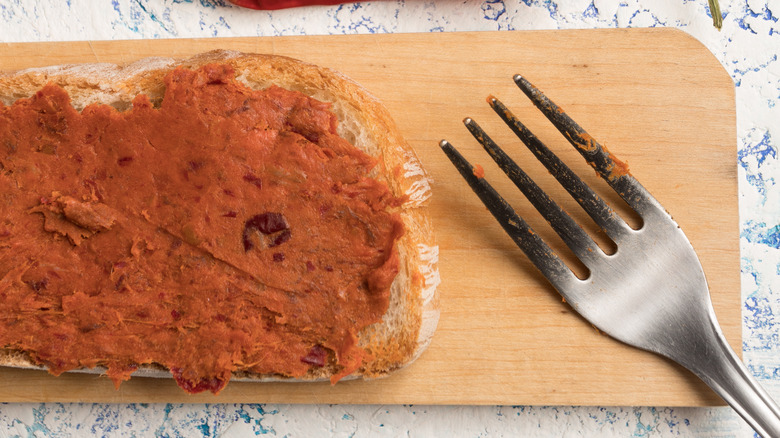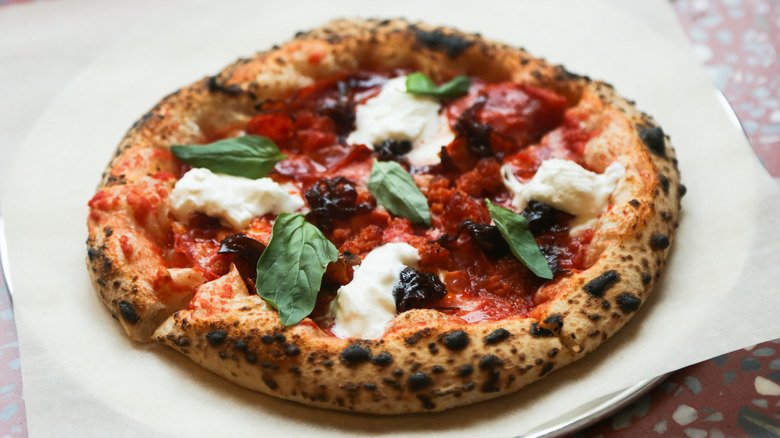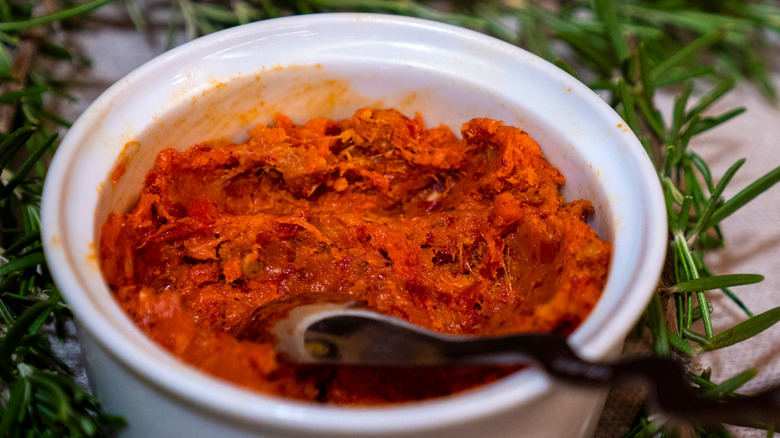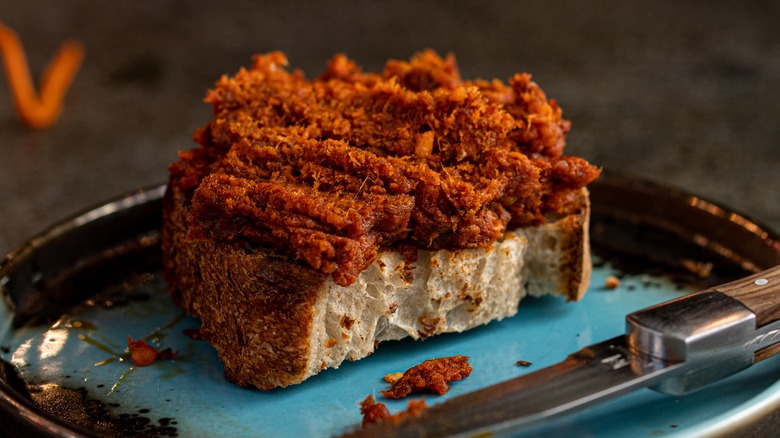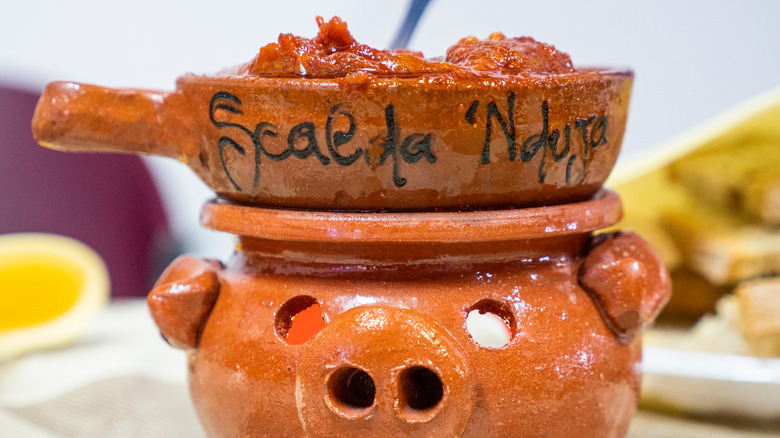The History Of 'Nduja Sausage And What Makes It A Unique Ingredient
The region of Calabria is the southernmost of mainland Italy. Using the ever-popular image of Italy as a boot, Calabria represents the toe and is characterized by its dry, arid climate and mountainscapes, as it serves as the southern terminus of the Apennine Range (via Britannica). As is true elsewhere in Italy, cured pork is an essential part of the Calabrian diet, per Salumi Pasini. The noticeable difference, and part of what makes Calabrian sausages so unique, is the manner in which they are made. Because Calabria's climate is unlike the cool and humid valley scapes of Emilia-Romagna, which are perfect for making cured hams, different methods and flavors dictate Calabria's special sausage: 'nduja.
According to MasterClass, 'nduja is a soft, pâté like sausage flavored with herbs, spices, and, most importantly, Calabrian chili peppers, a prized product of the region. 'Nduja is not like prosciutto or traditional salami in that it is solid and easy to slice. Rather, 'nduja is an intentionally spreadable sausage that can be found either packed into jars or whole in natural casings. It's a great sausage for everything from pizzas and pastas to soups and crostini. It's a sausage with a story as lively as the region it hails from. One that has, like its rival Sicily, been subject to numerous invasions over the course of its history.
What is 'nduja?
The history of 'nduja, pronounced "en – DOO – ya," ties into the colonial characteristics of the Calabrian region. However, you might be surprised to find that the origins don't date back nearly as far as some other Italian foods. Calabria has been subjected to numerous invading forces over the course of its history. In the 19th century, after a long occupation by Spain, Calabria came under the thumb of the French, courtesy of Napoleon Bonaparte (via Delicious Italy). It is thought that 'nduja came into existence during this transitionary period between Spanish and French rule.
The Spanish had long kept the rural Italians poor, so creating a sausage using the cheapest bits of the pig was a downright necessity. Combine this with the French influence in the early 19th century in the form of King Joachim Murat of Naples (a plant by Napoleon), and you have a cultural melting pot. It's believed that the French gave the Calabrians the idea to smoke their sausages, while 'nduja's softer, more spreadable nature bears several similarities to Spanish sobrassada. Andouille, a French smoked sausage, is thought to be the sausage that inspired both 'nduja's construction and as well as its name, which shares a similar pronunciation (via Bottega di Calabria). It is thought that the Calabrian people tweaked the andouille recipe by adding more bits of pork and throwing in a bunch of chilis for local flare.
How 'nduja is made?
'Nduja sausage hails from the Calabrian town of Spilinga in the district of Vibo Valentia. This area has a more temperate than mainland Calabria thanks to its proximity to the Tyrrhenian Sea. As we've seen, 'nduja was originally made with the cheapest parts of the pig, like the spleen, stomach, and lungs. Today, however, it is made with more quality cuts like neck fat, lard, pancetta, and guanciale. The ground meat is mixed in with the chilis that add spice, flavor, and antioxidants. The mixture is then stuffed into a natural casing, tied up, and hung for 24 hours to cure. After that period, two things can occur: the 'nduja is either smoked or immediately moved to a cooler room, where it will cure for several more weeks (via Great Italian Chefs and Nonna Box).
Like many other foods in Italy, 'nduja has a DOP label (designated protection of origin), meaning that the process for making the sausage is regulated to ensure that anything labeled as 'nduja di Spilinga is made according to historical tradition. The chili also represents paramount importance to the recipe. According to Chili Pepper Madness, Calabrian chilis are small and wrinkled when dried out but pack a spicy, fruity punch. They are what gives 'nduja its distinct, rusty red hue. One thing, too, you'll notice about properly made 'nduja is its buttery consistency, which is a result of all the minced pork fat in the mixture.
'Nduja vs andouille
Though 'nduja is certainly singular in its nature, the sausages it takes inspiration from are worth comparing in order to understand exactly what differentiates the three from each other. First, we have andouille. This sausage is constructed differently in the fact that the meat used is intentionally left chunky instead of minced or ground. Andouille is stuffed with a combination of pork meat, onions, garlic, herbs, spices, and wine, entirely into the large intestine of the pig, leading to an enormous sausage. Depending on what type you buy, andouille tends to be a more heavily seasoned sausage, likely due to it being a favorite in Cajun and Creole cooking, both of which are known for their bold flavors (via Chefin).
Andouille is a type of smoked sausage. One that's been smoked twice, to be precise. To begin with, the meat that goes into the andouille has already been smoked and seasoned. Once the sausages are formed, they are hung and smoked again. This double smoking leads to a very robust and intense flavor (via Home Kitchen Talk). Like 'nduja, andouille is boldly flavored, albeit in a very different way. Where 'nduja is flavored almost exclusively by the distinctly vibrant Calabrian chilis, andouille is often flavored with a variety of herbs and spices, which differ between sausage makers.
'Nduja vs sobrassada
Perhaps the only sausage in existence that can hold a candle to 'nduja in terms of flavor and consistency is the Spanish sobrassada. This is the second of the two sausages thought to have inspired Calabria's favorite pork product. According to Jamonarium, sobrassada is very popular on the Spanish-ruled, Balearic island of Mallorca. Like 'nduja, sobrassada is intentionally produced to be soft and shares a similar red hue. The chief difference is that the red in sobrassada comes from paprika. The remaining ingredients in sobrassada are lean pork, bacon, salt, and pepper stuffed into natural pork casing. The sausage dough is then left to ferment, which draws out moisture and gives the sausage its distinct texture and flavor.
Unlike andouille, which has a very brownish-grey color to it, 'nduja and sobrassada can be difficult to tell apart once the sausages have been removed from their casings. The proof, as they say, is in the pudding. Or, in this case, sausage. Sobrassada has a unique taste that is heavily influenced by the smoky paprika, which is the dominating flavor. Sobrassada is meant to be served raw and spread over toast or served with a variety of cheeses (via Culture Trip). It also holds its shape a little more than 'nduja, owning no doubt to its longer fermentation period, which allowed the sausage to firm up a bit (via Jamonarium).
What does 'nduja taste like?
To simply say that 'nduja has umami is to do something of a disservice to the array of complex flavors at play in this sausage. Indeed, 'nduja does have the savory factor so indicative of umami, but that's hardly the only flavor present. As we've mentioned, the Calabrian chili peppers play a major role in the overall flavor profile of 'nduja, per Sous Chef UK. The Calabrian chili peppers bring about a great spiciness to the 'nduja, which contrasts well with the meatiness of the pork. The sausage is also flavored with a variety of spices, herbs, and smokiness that bring out a depth of flavor (via Chili Pepper Madness).
Texture, too, has a large role to play in taste. If a food's texture is off, our taste seems to sour on it, per Food Navigator USA. According to Bon Appétit, the correct consistency for properly made 'nduja is that of soft butter. It should be easily spreadable on a piece of toasted bread. The soft texture of 'nduja makes it ideal for adding to sauces or pastas. Using olive oil and a little heat will practically dissolve 'nduja into anything you add it to, leaving behind its trademark spiciness (via Jamie Oliver on YouTube).
How to cook with and eat 'nduja
There are many that say 'nduja is best when served on its own with some lovely pieces of toasted bread. However, there are several different ways in which you can use 'nduja to add spice and complexity to a dish. One of the most popular ways is to use it as a topping for pizza. You can also stir it into some homemade sauce before placing out the rest of the toppings. And that's just the tip of the iceberg. With 'nduja's buttery nature, you can use it as a rub for chicken or steak, melt it in a skillet and toss croutons in it, turn it into a vinaigrette, or mix it into actual butter and roast vegetables in it (via Food 52).
MasterClass also recommends adding 'nduja to baked goods like muffins or biscuits in order to add a rich flavor. Speaking of baking with 'nduja, another thing you could do is make cheesy 'nduja bread bites, similar to pão de queijo. Combine 'nduja with tapioca flour, eggs, salt, milk, water, oil, parmesan, and cheddar, bake it into little, bite-sized, gluten-free balls, and serve alongside something like a whipped goats cheese.
Where to buy 'nduja
Fortunately, thanks to the fact that 'nduja has grown and remained immensely popular over the last few years, per Bloomberg, it is relatively easy to find for sale in the United States. Since the product cannot be sold in this country unless it has been first pasteurized, you won't find any in the original pork casing, per Food52. Instead, the 'nduja you find here in the States will be sold in sealed glass jars if it's been imported, like Tutto Calabria, or vacuum-wrapped plastic if it's a domestic product.
It's not as though you're going to miss out on 'nduja if you don't live in a city or town that has a specialty grocery store, though. If you live near a Whole Foods, you'll be able to find the stuff. In this age of modern technology, rural foodies need not be at the behest of a supermarket or bogged down by their own location. If you can't find it locally, have it shipped. Online many grocery stores or even Amazon are known to stock 'nduja. You can always purchase it straight from the manufacturer.
'Nduja nutrition
Let's be perfectly clear: 'nduja is a sausage. It is not a superfood in the sense that you are going to reap any long-lasting health benefits from consuming it in mass quantities. However, if enjoyment and happiness are factors in living a well-balanced and happy life, then adding a little 'nduja to your diet could increase your overall health state. Mentally, anyway. Though let's not forget that southern Italy was part of the 1950's studies that helped bring the Mediterranean Diet into the mainstream, per Food Insight. So there must be something beneficial to 'nduja apart from making us happy.
According to Food52, while an average salami is 80 percent lean pork meat to 20 percent fat, 'nduja is the opposite. The extra fat present in the 'nduja, thanks in no short part to the fact that it's made specifically with the fattier pork cuts, is what gives the 'nduja its buttery, spreadable characteristics.
La Querica's take on 'nduja
Despite 'nduja di Spilinga being legally protected, a fair amount of interpretation and variety is allowed for other butchers and meat specialists to make their own versions of the spreadable sausage. Some restaurants even make their own. One of the most respected American brands of 'nduja is the Iowa-based La Quercia. According to Bon Appétit, La Quercia's 'nduja is a favorite because of the quality of the ingredients. La Quercia uses the leftover trimmings from their speck and prosciutto production and mixes that together with New Mexican chilis. The resulting flavor is one of depth, sizzle, and overwhelming flavor.
La Quercia is one of those products you can buy at an Italian specialty store, as Food52 explains, or you can purchase it online straight from the makers or an online grocery. Another American 'nduja brand is Tempesta, based out of Chicago. According to Zingerman's, Tempesta uses a mix of top-quality Berkshire hogs for their meat, along with a combination of no less than five different chilis. Tempesta's 'nduja maker, Antonio Fiasche, is a fifth-generation maker whose grandfather still lives over in Calabria. This is as close to the real deal as you're gonna get from an American brand.
